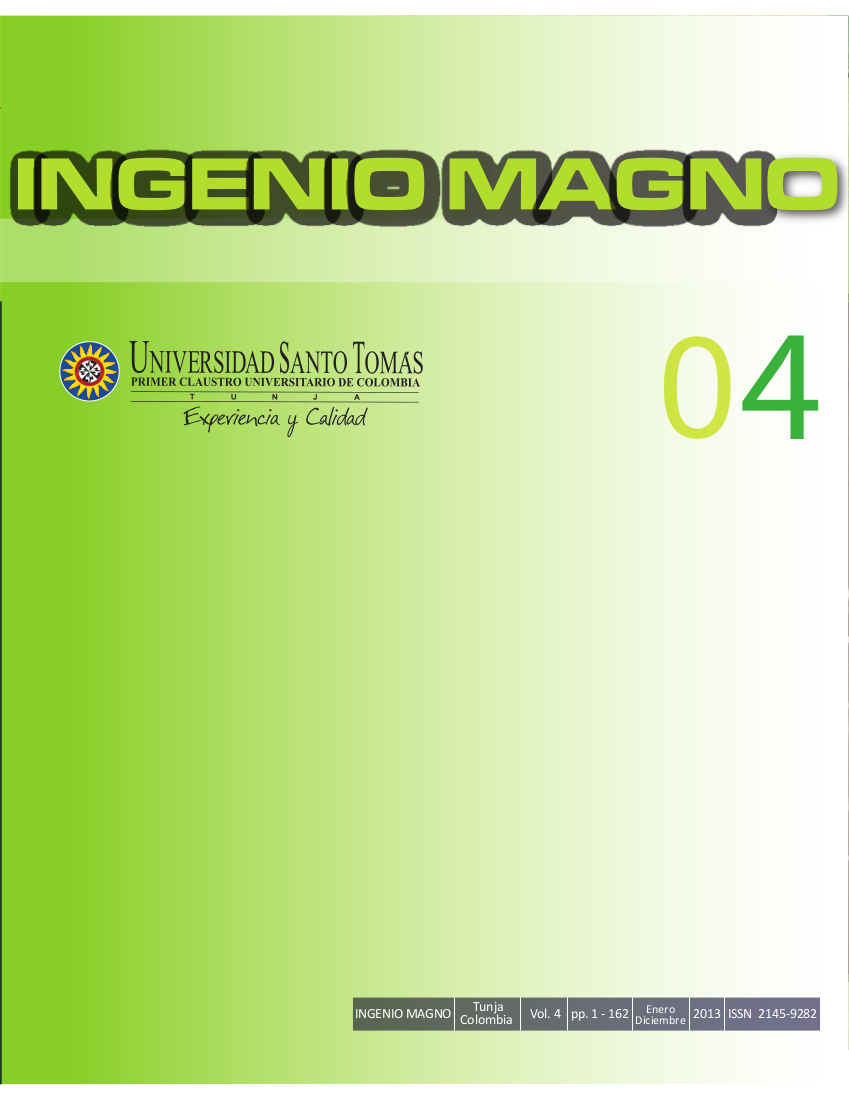Evaluación del potencial eólico en el campus de la Universidad Santo Tomás Tunja
Contenido principal del artículo
Resumen
Descargas
Detalles del artículo
DECLARACIÓN DE ORIGINALIDAD DE ARTÍCULO PRESENTADO
Por medio del presente documento, certifico(amos) que el artículo que se presenta para posible publicación en la revista institucional INGENIO MAGNO del Centro de Investigaciones de Ingeniería Alberto Magno CIIAM de la Universidad Santo Tomás, seccional Tunja, es de mi (nuestra) entera autoría, siendo su contenido producto de mi (nuestra) directa contribución intelectual y aporte al conocimiento.
Todos los datos y referencias a publicaciones hechas están debidamente identificados con su respectiva nota bibliográfica y en las citas que se destacan como tal. De requerir alguna clase de ajuste o corrección, comunicaré(emos) de tal procedimiento con antelación a los responsables de la revista.
Por lo anteriormente expresado, declaro(amos) que el material presentado en su totalidad se encuentra conforme a la legislación aplicable en materia de propiedad intelectual e industrial de ser el caso, y por lo tanto, me(nos) hago (hacemos) absolutamente responsable(s) de cualquier reclamación relacionada a esta.
En caso que el artículo presentado sea publicado, manifiesto(amos) que cedo(emos) plenamente a la Universidad Santo Tomás, seccional Tunja, los derechos de reproducción del mismo.
Citas
Fajardo-Díaz, J. L., García-Gonzáleza, J. M., & García-Saldívar, V. M. (2010). Evaluación del potencial eólico de una zona del estado de Zacatecas, México Evaluation of the eolic potencial of a zone located in the state of Zacatecas, Mexico, 2008–2011.
Fyrippis, I., Axaopoulos, P. J., & Panayiotou, G. (2010). Wind energy potential assessment in Naxos Island, Greece. Applied Energy, 87(2), 577–586.doi:10.1016/j.apenergy.2009.05.031
Hernández-Escobedo, Q., Espinosa-Arenal, F., Saldaña- Flores, R., & Rivera-Blanco, C. (2011). Evaluación del potencial eólico para la generación de energía eléctrica en el estado de veracruz, assessment to wind power for electricity generation in the state of veracruz (México), 215–221.
De Castro, C., Mediavilla, M., Miguel, L. J., & Frechoso, F. (2011). Global wind power potential: Physical and technological limits. Energy Policy, 39(10), 6677–6682. doi:10.1016/j. enpol.2011.06.027
Köse, R. (2004). An evaluation of wind energy potential as a power generation source in Kütahya, Turkey. Energy Conversion and anagement, 45(11-12), 1631–1641. doi:10.1016/j. enconman.2003.10.016
Oliver, J. (2009). Velocidad y dirección de viento para la evaluación del potencial eólico. Instituto de Ingeniería Eléctrica, Facultad de Ingeniería, Universidad de la República de Montevideo-Uruguay, 1–5.
Silva, B. B., Alves, J. J. A., Cavalcanti, E. P., & Dantas, R. T. (2002). direção P otencial eólico na dir eção pr edominante do v ent o no Nor deste br asileir o Nordeste brasileir asileiro predominante vent ento Wind energy potential for the prevailing, 431–439.
Studies, P. G. (2011). Analysis of seasonal Wind Speed and Wind Power Density Distribution in Aimangala Wind form At Chitradurga Karnataka using two Parameter Weibull Distribution, (3), 3–6.
Touré, S. (2005). Investigations on the Eigen‐coordinates method for the 2‐parameter weibull distribution of wind speed. Renewable Energy, 30(4), 511–521. doi:10.1016/j. renene.2004.07.007
UPME, U. de planeación minero energética, & Instituto de Hidrología, meteorología y estudios ambientales, I. (2006). Atlas de Viento y Energía Eólica de Colombia (p. 169).

